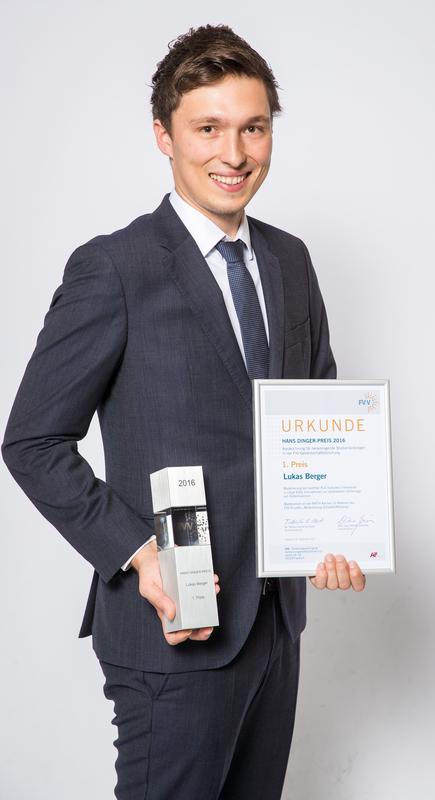Digital Simulations for Real World Engines and Turbines: FVV awards Hans Dinger Prize 2016

Hans Dinger-Award 2016 - 1st Prize: Lukas Berger FVV e.V. / Dirk Laessig, Fotograf
The 2016 award went to Lukas Berger, RWTH Aachen University, who studied in his master thesis the formation of soot emissions in aircraft gas turbine engines and developed a very fast operating simulation tool to enhance the prediction of the emissions.
Developing next-generation gas turbines with lower emissions
The FVV research project from which Lukas Berger’s master thesis has emerged dealt with a theoretical predictive model development of gas turbine emissions. Basically, developers may revert to various state-of-the-art simulation methods which differ in their level of detail. Direct Numerical Simulations (DNS) operate with a high accuracy which is comparable to experimental validations. However, due to their high computational burden they cannot be applied to real world aero engines.
That was the starting point of Berger’s master thesis: The aim was to investigate into the soot-turbulence interaction in a gas turbine combustion chamber on the basis of DNS data and to use these findings for simple Large-Eddy-Simulations (LES). By using a self-developed software he identified those DNS parameters that are relevant for modelling the formation of soot emissions.
In a next step, the young researcher developed an LES model to describe soot formation mechanisms for turbulent flames, which reduces the modelling errors by 50 per cent compared to existing approaches. “This model allows to predict soot-turbulence interactions in a fast and efficient way, which is a prerequisite for the design of next-generation low-emission gas turbines”, says Univ.-Prof. Dr.-Ing. Heinz Pitsch, Director of the Institute for Combustion Technology (ITV) at RWTH Aachen University.
Broadening the understanding of catalysts
The effectiveness of a catalytic converter depends on its operating temperature and various other factors. For catalysts that contain platinum or palladium as reactive component, FVV has studied in a research project the composition of a diesel oxidation catalyst, its aging and the nobel metal oxide formation. With his winning second place master thesis, Florian Bühner, University of Stuttgart, contributed to the overall project findings experimental validations on the chemistry of the reactions taking place on the catalyst.
In addition, he established a mathematical model for chemical reaction kinetics by taking into account the dynamic processes of noble metal oxide formation and reduction during catalyst operation. It turned out that Bühner’s mathematical calculations were identical with values well-known from the literature. “This master thesis contributes to a better understanding of reaction kinetics. By comparing additonal experimental validations with the simulations, the model’s design process could be further substantiated”, says Prof. Dr.-Ing. Ulrich Nieken, Director of the Institute of Chemical Process Engineering (ICVT) at the University of Stuttgart.
Increasing the durability of turbine blades
Third place winner, José Urbano from Leibniz University Hannover, dealt in his work assignment with aerodynamic stresses from turbomachinery blade vibrations. Very small, inevitable random variations in material composition and dimensions, resulting from the production process, together with the impact of external forces, resulting for example from the gas flow, may lead to very high vibration amplitudes and consequently to premature material failure. The FVV developed in a research project a simplified model approach, which should make it possible to identify critical vibration states of the blades already during the design phase of turbomachinery. Urbano’s work assignment focussed on the extension of simulations taking into account the aeroelastic interaction of oscillating blades. “The study work represents a significant extension of a substructure-based modelling procedure and thus contributes to improve the simulative vibration prediction of mistuned turbine blades”, explains Prof. Dr.-Ing. Jörg Wallaschek, Director of the Institute of Dynamics and Vibration Research (IDS) at Leibniz University Hannover.
Improving continuously the development of combustion engines
The prize winning research projects are part of the German Industrial Collective Research (IGF) Programme. They were financed by the Deutsche Forschungsgemeinschaft (DFG, German Research Foundation) and the FVV’s own research funds. Since 2006 the FVV has been awarding the Hans Dinger Prize every two years to three young scientists who have particularly contributed with their work to the success of IGF projects on the association’s evolving research agenda. The prize recognises the scientific excellence of the work, its practical relevance and, in particular, the innovative character of the result of the research. The 2016 HDP Award was presented in Magdeburg on 29th September as part of the FVV Autumn Meeting. The prize commemorates the former CEO and CTO of the MTU. Hans Dinger (1927 to 2010) promoted the idea of industrial collective research all his life. From 1989 until his death he was Honorary President of the FVV.
Media Contact
More Information:
http://www.fvv-net.deAll latest news from the category: Awards Funding
Newest articles

Silicon Carbide Innovation Alliance to drive industrial-scale semiconductor work
Known for its ability to withstand extreme environments and high voltages, silicon carbide (SiC) is a semiconducting material made up of silicon and carbon atoms arranged into crystals that is…

New SPECT/CT technique shows impressive biomarker identification
…offers increased access for prostate cancer patients. A novel SPECT/CT acquisition method can accurately detect radiopharmaceutical biodistribution in a convenient manner for prostate cancer patients, opening the door for more…

How 3D printers can give robots a soft touch
Soft skin coverings and touch sensors have emerged as a promising feature for robots that are both safer and more intuitive for human interaction, but they are expensive and difficult…





















